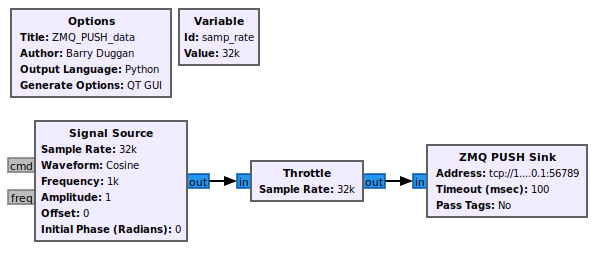ZMQ PUSH Sink: Difference between revisions
Jump to navigation
Jump to search
(clarify address) |
|||
| (4 intermediate revisions by 2 users not shown) | |||
| Line 9: | Line 9: | ||
; Address | ; Address | ||
: ZMQ socket address specifier. The format of the address is <code>tcp://*:port</code> where * should be 127.0.0.1 for localhost.<br> | : ZMQ socket address specifier. The format of the address is <code>tcp://*:port</code> where * should be 127.0.0.1 for localhost.<br> | ||
: <b>Note:</b> If the Source and Sink blocks are on two different computers on the same LAN, then the IP and port number of the Sink block must be specified on each end of that connection. For example, if the Sink is on IP 192.168.2.14:56789 and the Source is on IP 192.168.2.5, both Source and Sink blocks must specify the Sink IP and port (192.168.2.14:56789). | |||
; Timeout | ; Timeout | ||
: Receive timeout in milliseconds, default is 100ms. | : Receive timeout in milliseconds, default is 100ms. | ||
| Line 14: | Line 16: | ||
: Whether sink will serialize and pass tags over the link. | : Whether sink will serialize and pass tags over the link. | ||
; High Watermark | ; High Watermark | ||
: High Watermark | : High Watermark is the hard limit on the maximum number of outstanding messages that ZMQ will queue in the memory. The default value is set to -1. If there is to be no limit on the number of messages, set this value to zero. | ||
: <b>Note:</b> ZMQ does not guarantee that the socket will be able to queue as many messages as specified, and the actual limit may be lower or higher, depending on socket transport. | |||
== Example Flowgraph == | == Example Flowgraph == | ||
[[File:ZMQ_PUSH_data_fg.png]] | |||
== Source Files == | == Source Files == | ||
; C++ files | ; C++ files | ||
: [https://github.com/gnuradio/gnuradio | : [https://github.com/gnuradio/gnuradio/blob/main/gr-zeromq/lib/push_sink_impl.cc push_sink_impl.cc] | ||
; Header files | ; Header files | ||
: [https://github.com/gnuradio/gnuradio | : [https://github.com/gnuradio/gnuradio/blob/main/gr-zeromq/lib/push_sink_impl.h push_sink_impl.h] | ||
; Public header files | ; Public header files | ||
: [https://github.com/gnuradio/gnuradio | : [https://github.com/gnuradio/gnuradio/blob/main/gr-zeromq/include/gnuradio/zeromq/push_sink.h push_sink.h] | ||
; Block definition | ; Block definition | ||
: [https://github.com/gnuradio/gnuradio | : [https://github.com/gnuradio/gnuradio/blob/main/gr-zeromq/grc/zeromq_push_sink.block.yml zeromq_push_sink.block.yml] | ||
Latest revision as of 11:11, 3 February 2023
Sink the contents of a stream to a ZMQ PUSH socket.
This block acts a a streaming sink for a GNU Radio flowgraph and writes its contents to a ZMQ PUSH socket. A PUSH socket will round-robin send its messages to each connected ZMQ PULL socket, either another gr-zeromq source block or a regular, non-GNU Radio ZMQ socket.
Parameters
(R): Run-time adjustable
- Address
- ZMQ socket address specifier. The format of the address is
tcp://*:portwhere * should be 127.0.0.1 for localhost. - Note: If the Source and Sink blocks are on two different computers on the same LAN, then the IP and port number of the Sink block must be specified on each end of that connection. For example, if the Sink is on IP 192.168.2.14:56789 and the Source is on IP 192.168.2.5, both Source and Sink blocks must specify the Sink IP and port (192.168.2.14:56789).
- Timeout
- Receive timeout in milliseconds, default is 100ms.
- Pass Tags
- Whether sink will serialize and pass tags over the link.
- High Watermark
- High Watermark is the hard limit on the maximum number of outstanding messages that ZMQ will queue in the memory. The default value is set to -1. If there is to be no limit on the number of messages, set this value to zero.
- Note: ZMQ does not guarantee that the socket will be able to queue as many messages as specified, and the actual limit may be lower or higher, depending on socket transport.
Example Flowgraph
Source Files
- C++ files
- push_sink_impl.cc
- Header files
- push_sink_impl.h
- Public header files
- push_sink.h
- Block definition
- zeromq_push_sink.block.yml
